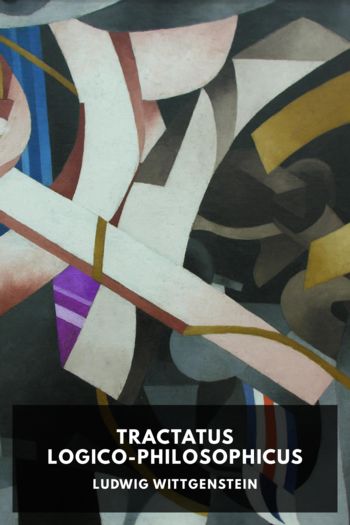Tractatus Logico-Philosophicus - Ludwig Wittgenstein (top 10 ebook reader TXT) 📗

- Author: Ludwig Wittgenstein
Book online «Tractatus Logico-Philosophicus - Ludwig Wittgenstein (top 10 ebook reader TXT) 📗». Author Ludwig Wittgenstein
And this is the case, for the symbols “p” and “q” presuppose “∨”, “~”, etc. If the sign “p” in “p∨q” does not stand for a complex sign, then by itself it cannot have sense; but then also the signs “p∨p”, “p.p”, etc. which have the same sense as “p” have no sense. If, however, “p∨p” has no sense, then also “p∨q” can have no sense.
5.5151Must the sign of the negative proposition be constructed by means of the sign of the positive? Why should one not be able to express the negative proposition by means of a negative fact? (Like: if “a” does not stand in a certain relation to “b”, it could express that aRb is not the case.)
But here also the negative proposition is indirectly constructed with the positive.
The positive proposition must presuppose the existence of the negative proposition and conversely.
5.52If the values of ξ are the total values of a function fx for all values of x, then N(ξ‾)=~(∃x).fx.
5.521I separate the concept all from the truth-function.
Frege and Russell have introduced generality in connection with the logical product or the logical sum. Then it would be difficult to understand the propositions “(∃x).fx” and “(x).fx” in which both ideas lie concealed.
5.522That which is peculiar to the “symbolism of generality” is firstly, that it refers to a logical prototype, and secondly, that it makes constants prominent.
5.523The generality symbol occurs as an argument.
5.524If the objects are given, therewith are all objects also given.
If the elementary propositions are given, then therewith all elementary propositions are also given.
5.525It is not correct to render the proposition “(∃x).fx”—as Russell does—in the words “fx is possible.”
Certainty, possibility or impossibility of a state of affairs are not expressed by a proposition but by the fact that an expression is a tautology, a significant proposition or a contradiction.
That precedent to which one would always appeal, must be present in the symbol itself.
5.526One can describe the world completely by completely generalized propositions, i.e. without from the outset coordinating any name with a definite object.
In order then to arrive at the customary way of expression we need simply say after an expression “there is one and only one x, which …”: and this x is a.
5.5261A completely generalized proposition is like every other proposition composite. (This is shown by the fact that in “(∃x,φ).φx” we must mention “φ” and “x” separately. Both stand independently in signifying relations to the world as in the ungeneralized proposition.)
A characteristic of a composite symbol: it has something in common with other symbols.
5.5262The truth or falsehood of every proposition alters something in the general structure of the world. And the range which is allowed to its structure by the totality of elementary propositions is exactly that which the completely general propositions delimit.
(If an elementary proposition is true, then, at any rate, there is one more elementary proposition true.)
5.53Identity of the object I express by identity of the sign and not by means of a sign of identity. Difference of the objects by difference of the signs.
5.5301That identity is not a relation between objects is obvious. This becomes very clear if, for example, one considers the proposition “(x):fx.⊃.x=a”. What this proposition says is simply that only a satisfies the function f, and not that only such things satisfy the function f which have a certain relation to a.
One could of course say that in fact only a has this relation to a, but in order to express this we should need the sign of identity itself.
5.5302Russell’s definition of “=” won’t do; because according to it one cannot say that two objects have all their properties in common. (Even if this proposition is never true, it is nevertheless significant.)
5.5303Roughly speaking: to say of two things that they are identical is nonsense, and to say of one thing that it is identical with itself is to say nothing.
5.531I write therefore not “f(a,b).a=b” but “f(aa)” (or “f(bb)”). And not “f(a,b).~a=b”, but “f(a,b)”.
5.532And analogously: not “(∃x,y).f(x,y).x=y”, but “(∃x).f(x,x)”; and not “(∃x,y).f(x,y).~x=y”, but “(∃x,y).f(x,y)”.
(Therefore instead of Russell’s “(∃x,y).f(x,y)”: “(∃x,y).f(x,y).∨.(∃x).f(x,x)”.)
5.5321Instead of “(x):fx⊃x=a” we therefore write e.g. “(∃x).fx.⊃.fa:~(∃x,y).fx.fy”.
And if the proposition “only one x satisfies f()” reads: “(∃x).fx:~(∃x,y).fx.fy”.
5.533The identity sign is therefore not an essential constituent of logical notation.
5.534And we see that the apparent propositions like: “a=a”, “a=b.b=c.⊃a=c”, “(x).x=x”. “





Comments (0)